\(\text{CH}_{3}\text{CH}_{2}\text{CH}_{3}\)
Structural formula:

Molecular formula: \(\text{C}_{3}\text{H}_{8}\)
|
Previous
4.1 What are organic molecules?
|
Next
4.3 IUPAC naming and formulae
|
Carbon has a number of unique properties which influence how it behaves and how it bonds with other atoms:
Carbon (Figure 4.2) has four valence electrons which means that each carbon atom can form a maximum of four bonds with other atoms. Because of the number of bonds that carbon can form with other atoms, organic compounds can be very complex.
Carbon can form bonds with other carbon atoms to form single, double or triple covalent bonds.
Carbon can also form bonds with other atoms like hydrogen, oxygen, nitrogen and the halogens.
Carbon can bond to form straight chain, branched, and cyclic molecules.

Figure 4.2: Carbon (a) as seen on the periodic table and (b) a Lewis dot representation.
Because of this, long chain structures can form. This is known as catenation - the bonding of atoms of the same element into longer chains. These chains can either be unbranched (Figure 4.3) or branched (have a branched group, Figure 4.4) and can contain single carbon-carbon bonds only, or double and triple carbon-carbon bonds as well.

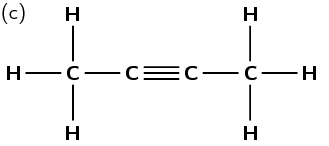
Figure 4.3: Unbranched carbon chains with (a) single carbon-carbon bonds, (b) single and double carbon-carbon bonds and (c) single and triple carbon-carbon bonds.

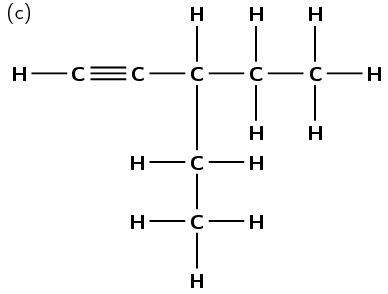
Figure 4.4: Branched carbon chains with (a) single carbon-carbon bonds, (b) single and double carbon-carbon bonds and (c) single and triple carbon-carbon bonds.
Because of its position on the periodic table, most of the bonds that carbon forms with other atoms are covalent. Think for example of a \(\text{C}-\text{C}\) bond. The difference in electronegativity between the two atoms is zero, so this is a pure covalent bond. In the case of a \(\text{C}-\text{H}\) bond, the difference in electronegativity between carbon (\(\text{2,5}\)) and hydrogen (\(\text{2,2}\)) is so small that \(\text{C}-\text{H}\) bonds are almost purely covalent. The result of this is that most organic compounds are non-polar. This affects some of the properties of organic compounds.
The main source of the carbon in organic compounds is carbon dioxide in the atmosphere. Plants use sunlight to convert carbon dioxide and water (inorganic compounds) into sugar (an organic compound) through the process of photosynthesis.
\(6\text{CO}_{2}(\text{g}) + 6\text{H}_{2}\text{O}(\text{ℓ})\) \(\to\) \(\text{C}_{6}\text{H}_{12}\text{O}_{6}(\text{aq}) + 6\text{O}_{2}(\text{g})\)
Plants are therefore able to make their own organic compounds through photosynthesis, while animals feed on plants or plant products in order to gain the organic compounds that they need to survive.
Other important sources of carbon are fossil fuels such as coal, petroleum and natural gas. This is because fossil fuels are themselves formed from the decaying remains of dead organisms.
There are a number of ways to represent organic compounds. It is useful to know all of these so that you can recognise a molecule regardless of how it is shown. There are four main ways of representing a compound in two dimensions (on your page). We will use the examples of two molecules called 2-methylpropane and butane to help explain the difference between each.
Structural formula
The structural formula of an organic compound shows every bond between every atom in the molecule. Each bond is represented by a line. The structural formulae of 2-methylpropane and butane are shown in Figure 4.5.

Figure 4.5: The structural formula of (a) 2-methylpropane and (b) butane.

Figure 4.6: Different ways of representing a carbon atom bonding to four hydrogen atoms.
Semi-structural formula
It is possible to understand the structure of an organic molecule without writing out all the carbon-hydrogen bonds. This way of writing a structure is called a semi-structural formula and is shown in Figure 4.7.

Figure 4.7: The semi-structural formulae of (a) 2-methylpropane and (b) butane.
Compare these semi-structural representations with the structural representations shown in Figure 4.5.
A substituent is an atom or group of atoms that replaces a hydrogen atom on the main chain of an organic molecule. Therefore a brached group is a substituent. A halogen atom can also be a substituent.
Condensed structural formula
It is also possible to represent a molecule without showing any bonds between atoms at all. This is called a condensed structural formula (Figure 4.8). As for a semi-structural representation, the carbon atoms are grouped with the hydrogen atoms bonded directly to it. The bonds between these groups are not shown. Branched or substituent groups are shown in brackets after the carbon atom to which they are bonded.

Figure 4.8: The condensed structural formulae of (a) 2-methylpropane and (b) butane.
Note that in Figure 4.8 (b) the two \(\text{CH}_{2}\) groups can be abbreviated to \((\text{CH}_{2})_{2}\). Compare these condensed structural representations with the structural (Figure 4.5) and the semi-structural representations (Figure 4.7).
Molecular formula
The molecular formula of a compound shows how many atoms of each type are in a molecule. The number of each atom is written as a subscript after the atomic symbol. The molecular formula of 2-methylpropane is:
\(\text{C}_{4}\text{H}_{10}\)
This means that each molecule of 2-methylpropane consists of four carbon atoms and ten hydrogen atoms. The molecular formula of butane is also \(\text{C}_{4}\text{H}_{10}\). Molecular formula gives no structural information about the compound.
Of course molecules are not two-dimensional so shown below are a few examples of different ways to represent methane (\(\text{CH}_{4}\), Figure 4.9) and ethane (\(\text{C}_{2}\text{H}_{6}\), Figure 4.10).

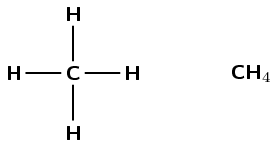
Figure 4.9: Different ways of representing methane.

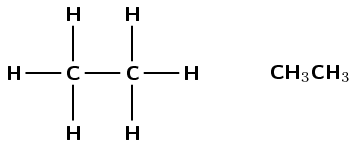
Figure 4.10: Different ways of representing ethane.
This means that butane can be represented in two dimensions as shown in Figure 4.11 (a) but it actually looks more like the three-dimensional representation given in Figure 4.11 (b).
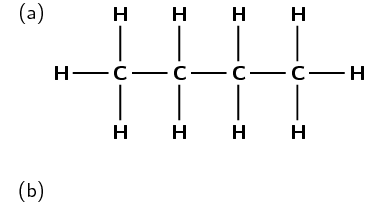
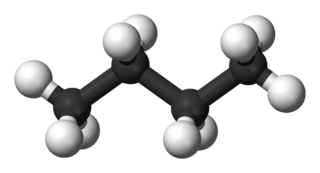
Figure 4.11: (a) Two-dimensional and (b) three-dimensional representations of butane.
For each of the following, give the structural formula and the molecular formula.
\(\text{CH}_{3}\text{CH}_{2}\text{CH}_{3}\)
Structural formula:

Molecular formula: \(\text{C}_{3}\text{H}_{8}\)
\(\text{CH}_{3}\text{CH}_{2}\text{CH}(\text{CH}_{3})\text{CH}_{3}\)
Structural formula:

Although the condensed formula was written with the methyl group attached to the third carbon, if we look at the formula from right to left you will see that it is attached to the second carbon and so either of the representations given above are acceptable.
Molecular formula: \(\text{C}_{5}\text{H}_{12}\)
\(\text{CH}_{3}\text{CH}_{3}\)
Structural formula:
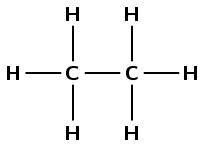
Molecular formula: \(\text{C}_{2}\text{H}_{6}\)
For each of the following organic compounds, give the condensed structural formula and the molecular formula.
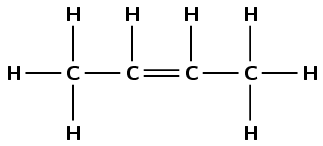
Condensed Structural: \(\text{CH}_{3}\text{CHCHCH}_{3}\)
Molecular: \(\text{C}_{4}\text{H}_{8}\)
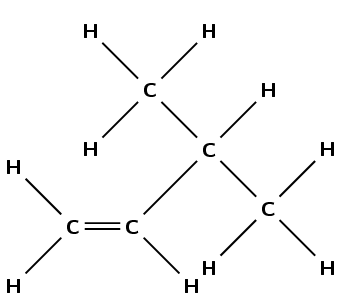
Condensed Structural: \(\text{CH}_{2}\text{CHCH}(\text{CH}_{3})\text{CH}_{3}\)
Molecular: \(\text{C}_{5}\text{H}_{10}\)
Give two possible structural formulae for the compound with a molecular formula of \(\text{C}_{4}\text{H}_{10}\).
The only two possible options are:
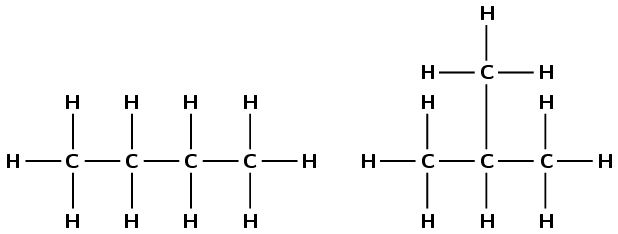
The way in which a compound will react is determined by a particular characteristic of a group of atoms and the way they are bonded (e.g. double C\(-\)C bond, C\(-\)OH group). This is called the functional group. This group is important in determining how a compound will react. The same functional group will undergo the same or similar chemical reaction(s) regardless of the size of the molecule it is a part of. Molecules can have more than one functional group.
In organic chemistry a functional group is a specific group of atoms (and the bonds between them) that are responsible for the characteristic chemical reactions of those molecules.
In one group of organic compounds, called the hydrocarbons, the single, double and triple bonds between carbon atoms give rise to the alkanes, alkenes and alkynes, respectively. The double carbon-carbon bonds (in the alkenes) and triple carbon-carbon bonds (in the alkynes) are examples of functional groups.
In another group of organic compounds, called the alcohols, an oxygen and a hydrogen atom are bonded to each other to form the functional group (in other words an alcohol has an \(\text{OH}\) in it). All alcohols will contain an oxygen and a hydrogen atom bonded together in some part of the molecule.
Table 4.1 summarises some of the common functional groups. We will look at these in more detail later in this chapter.
|
Name of group |
Functional group |
Example |
Structural Formula |
|
Alkane |
 |
Ethane |
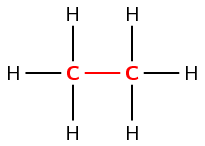 |
|
Alkene |
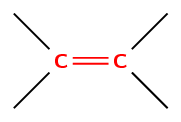 |
Ethene |
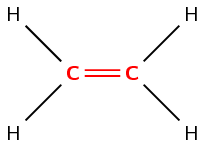 |
|
Alkyne |
 |
Ethyne |
 |
|
Haloalkane/alkyl halide |
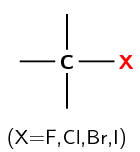 |
Chloromethane |
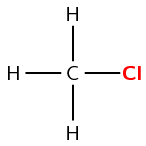 |
|
Alcohol / alkanol |
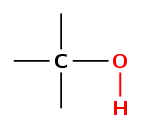 |
Methanol |
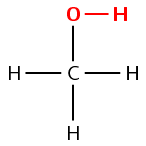 |
|
Carboxylic acid |
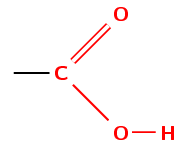 |
Methanoic acid |
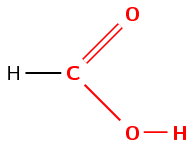 |
Table 4.1: Some functional groups of organic compounds.
There are some important points to note as we discuss functional groups:
The beginning of a compound name (prefix) comes from the number of carbons in the longest chain:
|
meth- |
1 carbon atom |
|
eth- |
2 carbon atoms |
|
prop- |
3 carbon atoms |
|
but- |
4 carbon atoms |
The end of a compound name (suffix) comes from the functional group, e.g. an alkane has the suffix -ane. Refer to the examples in Table 4.1.
For more information on naming organic molecules see Section 4.3.
Hydrocarbons that contain only single bonds are called saturated hydrocarbons because each carbon atom is bonded to as many hydrogen atoms as possible. Figure 4.12 shows a molecule of ethane, which is a saturated hydrocarbon.
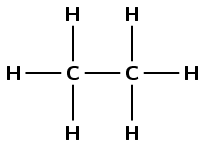
Figure 4.12: A saturated hydrocarbon, ethane.
A saturated compound has no double or triple bonds (i.e. they have single bonds only). All carbon atoms are bonded to four other atoms.
Hydrocarbons that contain double or triple bonds are called unsaturated hydrocarbons because they don't contain as many hydrogen atoms as possible.
An unsaturated compound contains double or triple bonds. A carbon atom may therefore be bonded to only two or three other atoms.
Figure 4.13 shows molecules of ethene and ethyne which are unsaturated hydrocarbons. If you compare the number of carbon and hydrogen atoms in a molecule of ethane and a molecule of ethene, you will see that the number of hydrogen atoms in ethene is less than the number of hydrogen atoms in ethane despite the fact that they both contain two carbon atoms. In order for an unsaturated hydrocarbon compound to become saturated, one of the two (or three) bonds in a double (or triple) bond has to be broken, and additional atoms added.

Figure 4.13: Unsaturated hydrocarbons: (a) ethene and (b) ethyne.
Let us first look at a group of organic compounds known as the hydrocarbons.
An organic molecule which contains only carbon and hydrogen atoms with no other functional groups besides single, double or triple carbon-carbon bonds.
The hydrocarbons that we are going to look at are called aliphatic compounds. The aliphatic compounds are divided into acyclic compounds (chain structures) and cyclic compounds (ring structures). The chain structures are further divided into structures that contain only single bonds (alkanes), those that contain at least one double bond (alkenes) and those that contain at least one triple bond (alkynes).
Cyclic compounds (which will not be covered in this book) include structures such as a cyclopentane ring, which is found in insulating foam and in appliances such as fridges and freezers. Figure 4.14 summarises the classification of the hydrocarbons.

Figure 4.14: The classification of the aliphatic hydrocarbons.
An aliphatic compound is one that does not contain an aromatic ring:
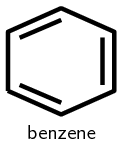
The simplest aromatic compound is benzene. There are aliphatic cyclic compounds, but if a compound contains an aromatic ring it is an aromatic compound, not an aliphatic one.
We will now look at each of the acyclic, aliphatic hydrocarbon groups in more detail.
The alkanes are hydrocarbons that only contain single covalent bonds between their carbon atoms. This means that they are saturated compounds and are quite unreactive. The simplest alkane has only one carbon atom and is called methane. This molecule is shown in Figure 4.15.

Figure 4.15: The (a) structural and (b) molecular formula representations of methane.
The second alkane in the series has two carbon atoms and is called ethane. This is shown in Figure 4.16.

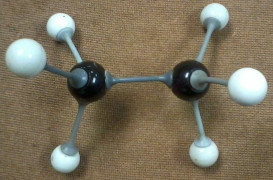
Figure 4.16: The (a) structural, (b) condensed structural and (c) molecular formula representations of ethane. (d) An atomic model of ethane.
The third alkane in the series has three carbon atoms and is called propane (Figure 4.17).

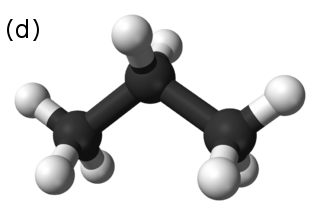
Figure 4.17: The (a) structural, (b) condensed structural and (c) molecular formula representations of propane. (d) A three-dimensional computer generated model of propane.
When you look at the molecular formula for each of the alkanes, you should notice a pattern developing. For each carbon atom that is added to the molecule, two hydrogen atoms are added. In other words, each molecule differs from the one before it by \(\text{CH}_{2}\). This is called a homologous series.
A homologous series is a series of compounds with the same general formula. All molecules in this series will contain the same functional groups.
Some fungi use alkanes as a source of carbon and energy. One fungus amorphotheca resinae (also known as kerosene fungus) prefers the alkanes used in aviation fuel, and this can cause problems for aircraft in tropical areas.
The general formula is similar to both the molecular formula and the condensed structural formula. The functional group is written as it would be in the condensed structural formula (to make it more obvious), while the rest of the atoms in the compound are written in the same style as the molecular formula. The alkanes have the general formula: \(\color{red}{\textbf{C}_{\textbf{n}}\textbf{H}_{\textbf{2n+2}}}\).
The alkanes are the most important source of fuel in the world and are used extensively in the chemical industry.
Alkanes that contain four or less carbon atoms are gases (e.g. methane and ethane).
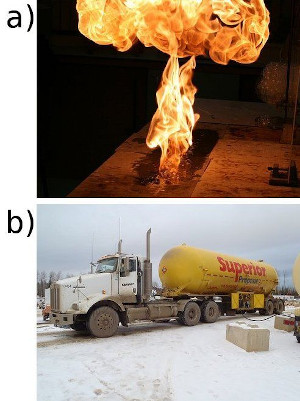
(a) Methane gas bubbles burning and (b) propane (under high pressure) being transported by truck.
Others are liquid fuels (e.g. octane, an important component of petrol).
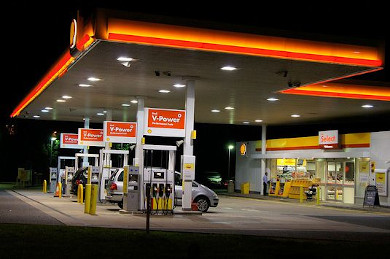
Figure 4.19: Liquid fuels that contain octane are kept in tanks at petrol stations.
In the alkenes there must be at least one double bond between two carbon atoms. This means that they are unsaturated and are more reactive than the alkanes. The simplest alkene is ethene (also known as ethylene), which is shown in Figure 4.20.

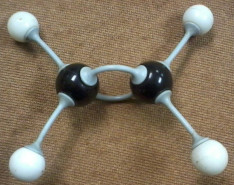
Figure 4.20: The (a) structural, (b) condensed structural and (c) molecular formula representations of ethene. (d) An atomic model of ethene.
As with the alkanes, the alkenes also form a homologous series. They have the general formula: \(\color{red}{\textbf{C}_{\textbf{n}}\textbf{H}_{\textbf{2n}}}\). The second alkene in the series would therefore be \(\text{C}_{3}\text{H}_{6}\). This molecule is known as propene (Figure 4.21).

Figure 4.21: The (a) structural, (b) condensed structural and (c) molecular formula representations of propene.
There can be more than one double bond in an alkene as shown in Figure 4.22. The naming of these compounds is covered in Section 4.3, IUPAC naming and formulae.
Note that if an alkene has two double bonds, it is called a diene.
If you don't understand the names of compounds, don't worry. We will go into more detail on this later in the chapter.

Figure 4.22: The structural representations of (a) pent-1-ene and (b) pent-1,3-diene.
The alkenes are more reactive than the alkanes because they are unsaturated. As with the alkanes, compounds that have four or less carbon atoms are gases at room temperature. Those with five or more carbon atoms are liquids.
The alkenes have a variety of uses:
For example, ethene is a chemical compound used in plants to stimulate the ripening of fruits and the opening of flowers.
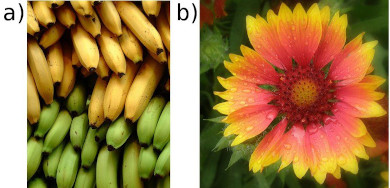
(a) Unripe (green) and ripe (yellow) bananas and (b) a flowering plant.
Propene is an important compound in the petrochemicals industry. It is used to make polypropylene (see Section 4.7 for more information) and is also used as a fuel gas for other industrial processes.
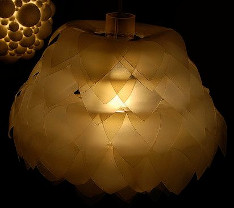
Figure 4.24: A lamp made of polypropylene. Propene is used to make polypropylene.
In the alkynes there must be at least one triple bond between two of the carbon atoms. They are unsaturated compounds and are therefore more reactive than alkanes. Their general formula is \(\color{red}{\textbf{C}_{\textbf{n}}\textbf{H}_{\textbf{2n-2}}}\). For example but-1-yne has the molecular formula \({\textbf{C}_{4}{\textbf{H}_{6}}}\). The simplest alkyne is ethyne (Figure 4.25), also known as acetylene. Many of the alkynes are used to synthesise other chemical products.
Acetylene is the industrial name for the organic compound ethyne. The raw materials that are needed to make acetylene are calcium carbonate and coal. An important use of acetylene is in oxyacetylene gas welding. The fuel gas burns with oxygen in a torch. Because the combustion of alkenes and alkynes is exothermic an incredibly high heat is produced, which is hot enough to melt metal.
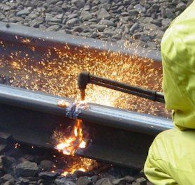


Figure 4.25: The (a) structural, (b) condensed structural and (c) molecular representations of ethyne (acetylene). (d) An atomic model of ethyne.
Remember that organic molecules do not need to be straight chains. They can have branched groups as well, as shown in Figure 4.26.
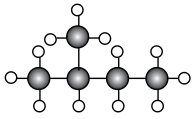
Figure 4.26: A methyl branched group on carbon 2 of butane (2-methylbutane).
A summary of the relative reactivity and the homologous series that occur in the hydrocarbons is given in Table 4.2.
|
Functional group |
Homologous series |
Reactivity |
|
alkane |
\(\color{red}{\textbf{C}_{\textbf{n}}\textbf{H}_{\textbf{2n+2}}}\) |
low reactivity |
|
alkene |
\(\color{red}{\textbf{C}_{\textbf{n}}\textbf{H}_{\textbf{2n}}}\) |
high reactivity |
|
alkyne |
\(\color{red}{\textbf{C}_{\textbf{n}}\textbf{H}_{\textbf{2n-2}}}\) |
high reactivity |
Table 4.2: A summary of the homologous series of the hydrocarbons.
Liquid bromine is highly corrosive and toxic. Handle with extreme care!
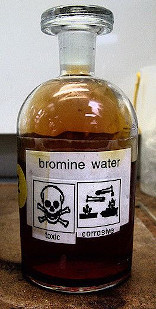
For the experiment on saturated and unsaturated compounds, if cyclohexane and cyclohexene are not available any alkanes/alkenes that are liquids at room temperature are acceptable. These should be relatively easy to source.
Liquid bromine is corrosive and toxic, including the fumes. If you have to prepare your own bromine water from liquid bromine do not let the learners handle the liquid bromine. Wear full safety gear and do not breath in the fumes. Work in a well ventilated area (preferably a fume hood) and be careful.
To make \(\text{50}\) \(\text{ml}\) bromine water:
Take a bottle with a capacity of at least \(\text{100}\) \(\text{ml}\) and a lid that closes securely (screw top).
Label the bottle and place \(\text{50}\) \(\text{ml}\) of water into the bottle.
Decant the vapours from a bottle of liquid bromine (with appropriate precautions) into the labelled bottle until the airspace above the water is completely full of the reddish-brown gas.
Cap both bottles and gently swirl the bromine water bottle so that the bromine gas dissolves in the water.
Repeat the process at least one more time, until the water retains an orange colour.
To study the effect of bromine water and potassium permanganate on saturated and unsaturated compounds.
Liquid bromine (required to make bromine water) is a highly volatile, corrosive and toxic compound. Please handle with care: wear the appropriate safety clothing including gloves, labcoat, safety glasses and mask. Work in a fumehood. If you do not have the apparatus to handle liquid bromine safely, use potassium permanganate only.
cyclohexane, cyclohexene, bromine water (\(\text{Br}_{2}(\text{aq})\)), potassium permanganate (\(\text{KMnO}_{4}\)) in an acidic solution
4 glass containers (test tubes/beakers/shallow basins), two A4 sheets of paper
2 plastic pipettes
Label one piece of paper A and the other piece of paper B.
Place \(\text{20}\) \(\text{ml}\) of cyclohexane into a container and place the container on paper A.
Place \(\text{20}\) \(\text{ml}\) of cyclohexane into a container and place the container on paper B.
Repeat steps 2 and 3 with cyclohexene.
Take \(\text{12}\) \(\text{ml}\) of bromine water and add it to the beaker of cyclohexane on paper A. Observe any colour changes.
Repeat step 5 with the beaker of cyclohexene on paper A.
Take \(\text{12}\) \(\text{ml}\) of \(\text{KMnO}_{4}\) and add it to the beaker of cyclohexane on paper B. Observe any colour changes.
Repeat step 7 with the beaker of cyclohexene on paper B.
Record your results in the table below.
|
Compound |
Initial colour |
Solution added |
Final colour |
|
cyclohexane |
bromine water |
||
|
cyclohexane |
\(\text{KMnO}_{4}\) |
||
|
cyclohexene |
bromine water |
||
|
cyclohexene |
\(\text{KMnO}_{4}\) |
Cyclohexane is an alkane, cyclohexene is an alkene.
Which of these compounds (cyclohexane, cyclohexene) is saturated and which is unsaturated?
What colour changes did you observe with the alkane compound?
What colour changes did you observe with the alkene compound?
Can you suggest a reason for the differences?
Bromine water and \(\text{KMnO}_{4}\) both have intense colours. Cyclohexane is a saturated, colourless liquid. When bromine water and \(\text{KMnO}_{4}\) are added to the cyclohexane there is no reaction and the solution becomes the colour of the bromine water or \(\text{KMnO}_{4}\).
Cyclohexene is also a colourless liquid, but it is unsaturated. This results in a reaction with bromine water and with \(\text{KMnO}_{4}\). Cyclohexene will form a bromoalkane with bromine water. Bromoalkanes are colourless liquids and the solution will be colourless - liquid bromine is decolourised by cyclohexene. Similarly \(\text{KMnO}_{4}\) will be decolourised by the cyclohexene.
Answer these questions on the hydrocarbons.
What is the difference between the alkanes, alkenes and alkynes?
Alkanes have only single bonds between carbon atoms, alkenes have at least one double bond between carbon atoms and alkynes have at least one triple bond between carbon atoms.
Give the general formula for the alkynes
\(\text{C}_{\text{n}}\text{H}_{2\text{n}-2}\)
Of the alkanes, alkenes and alkynes which is:
saturated
the alkanes
unsaturated
the alkenes and alkynes
Which series is the least reactive? Explain why.
The alkanes are the least reactive. The saturated bonds are more reactive than the unsaturated double or triple bonds found in alkenes and alkynes.
Draw the structural formulae for:
\(\text{CHCCH}_{3}\)

\(\text{CH}_{3}\text{CH}_{2}\text{CH}_{3}\)
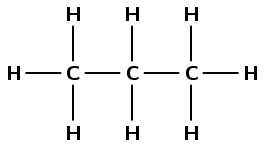
\(\text{CH}_{2}\text{CHCH}_{3}\)

Fill in the table below:
|
Compound |
Saturated or unsaturated? |
|
\(\text{CH}_{3}\text{CH}_{2}\text{CH}_{3}\) |
|

|
|
|
\(\text{CH}_{3}\text{CH}_{2}\text{CHCHCH}_{2}\text{CH}_{2}\text{CH}_{2}\text{CH}_{3}\) |
|
|
heptane |
|

|
|
Compound |
Saturated or unsaturated? |
|
\(\text{CH}_{3}\text{CH}_{2}\text{CH}_{3}\) |
saturated |

|
unsaturated |
|
\(\text{CH}_{3}\text{CH}_{2}\text{CHCHCH}_{2}\text{CH}_{2}\text{CH}_{2}\text{CH}_{3}\) |
unsaturated |
|
heptane |
saturated |

|
unsaturated |
An alcohol is any organic compound where there is a hydroxyl functional group \((-\text{OH})\) bound to a carbon atom. The general formula for a simple alcohol is \(\color{red}{\textbf{C}_{\textbf{n}}\textbf{H}_{\textbf{2n+1}}\textbf{OH}}\).
The simplest and most commonly used alcohols are methanol and ethanol (Figures Figure 4.27 and Figure 4.28).
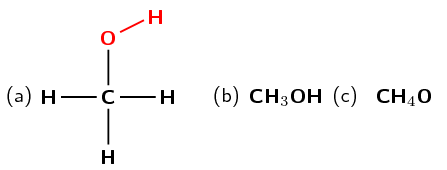
Figure 4.27: The (a) structural, (b) condensed structural and (c) molecular formula representations of methanol.

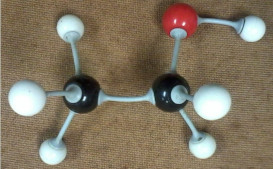
Figure 4.28: The (a) structural, (b) condensed structural and (c) molecular formula representations of ethanol. (d) An atomic model of ethanol.
There are three possible types of carbon atoms - primary, secondary and tertiary. A primary carbon is attached to only one other carbon atom. A secondary carbon is attached to two other carbon atoms, while a tertiary carbon atom is attached to three other carbon atoms.
Make sure the learners understand the difference between pirmary, secondary and tertiary carbons:
Primary
A primary carbon is a carbon atom bonded to one other carbon atom.
Secondary
A secondary carbon is a carbon atom bonded to two other carbon atoms.
Tertiary
A tertiary carbon is a carbon atom bonded to three other carbon atoms.
For example:
\(\text{CH}_{3}\text{CH}_{2}\text{CH}_{3}\), carbon 1 and carbon 3 are primary carbon atoms because they are only bonded to one other carbon atom. Carbon 2 is a secondary carbon atom because it is bonded to two other carbon atoms.
\(\text{C}(\text{CH}_{3})_{3}\text{X}\), The central carbon atom in this compound is a tertiary carbon atom because it is bonded to three other carbon atoms.
A primary alcohol has the hydroxyl (\(-\text{OH}\)) group bonded to a primary carbon atoms. Similarly, a secondary alcohol has the hydroxyl bonded to a secondary carbon atom and a tertiary alcohol has the hydroxyl bonded to a tertiary carbon atom.
There can be a functional group attached to these different types of carbon atom. When a hydroxyl \((-\text{OH})\) functional group is attached to a primary carbon atom it is called a primary alcohol. For a secondary alcohol the hydroxyl is bonded to a secondary carbon atom. When the hydroxyl is bonded to a tertiary carbon atom it is a tertiary alcohol. Examples are given below.
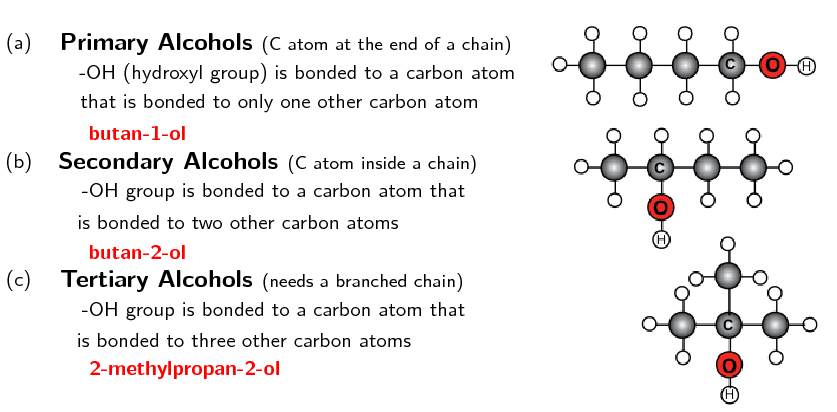
Figure 4.29: A (a) primary (butan-1-ol), (b) secondary (butan-2-ol) and (c) tertiary
(2-methylpropan-2-ol) alcohol.
The alcohols have a number of different uses:
methylated spirits is ethanol with methanol added
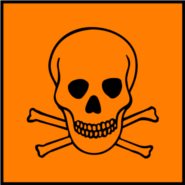
Methanol is toxic. If ingested it forms formic acid or formate salts, which damage the central nervous system and can cause blindness, coma or death.
all alcohols are toxic, but in low concentrations ethanol can be used in alcoholic drinks
ethanol is the only alcohol used in alcoholic drinks
ethanol is used as an industrial solvent
methanol and ethanol can both be used as a fuel and they burn more cleanly than petrol or diesel.
ethanol is used as a solvent in medical drugs, perfumes and plant essences
ethanol is an antiseptic
Give the structural and condensed structural formula for the following alcohols. State, with reasons, whether the compound is a primary, secondary, or tertiary alcohol.
(Note: a black ball represents a carbon atom, a white ball represents a hydrogen atom, and a red ball represents an oxygen atom)
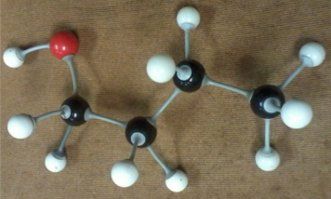

\(\text{CH}_{3}\text{CH}_{2}\text{CH}_{2}\text{CH}_{2}\text{OH}\) or \(\text{CH}_{2}(\text{OH})\text{CH}_{2}\text{CH}_{2}\text{CH}_{3}\)
This is a primary alcohol. The hydroxyl (\(-\text{OH}\)) group is bonded to a carbon atom that is bonded to only one other carbon atom.
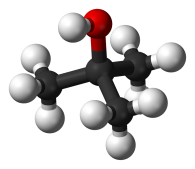
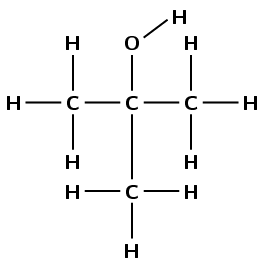
\(\text{CH}_{3}\text{C}(\text{CH}_{3})(\text{OH})\text{CH}_{3}\) or \(\text{CH}_{3}\text{C}(\text{OH})(\text{CH}_{3})\text{CH}_{3}\)
This is a tertiary alcohol. The hydroxyl (\(-\text{OH}\)) group is bonded to a carbon atom that is bonded to three other carbon atoms.
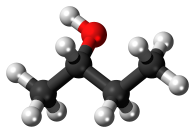

\(\text{CH}_{3}\text{CH}_{2}\text{CH}(\text{OH})\text{CH}_{3}\) or \(\text{CH}_{3}\text{CH}(\text{OH})\text{CH}_{2}\text{CH}_{3}\)
This is a secondary alcohol. The hydroxyl (\(-\text{OH}\)) group is bonded to a carbon atom that is bonded to two other carbon atoms.
Alkyl halides are hydrocarbons with one hydrogen atom replaced by a halogen atom (F, Cl, Br, I). The alkyl is due to the fact that a hydrocarbon branched group has the suffix -yl and is one of the three hydrocarbons: alkanes, alkenes or alkynes. These alkyl groups contain one or more halogen atoms, which leads to the name alkyl halides. Our focus will be on the alkane alkyl halides also known as the haloalkanes (or halogenoalkanes) (see Table 4.1).
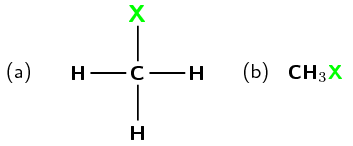

Figure 4.30: Representations of a halomethane where X can be F, Cl, Br or I: (a) structural, (b) molecular formula, (c) 3-D line drawing, (d) 3-D ball and stick model and e) 3-D space-filling model.


Figure 4.31: Representations of 2-halopropane where X can be F, Cl, Br or I: (a) structural, (b) condensed structural, (c) molecular formula and (d) a ball and stick model.
Note that the halogen atom is called a substituent.
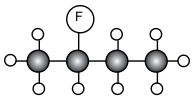
Figure 4.32: A fluorine atom as a substituent on carbon 2 of butane (2-fluorobutane).
Remember the branched chain shown in Figure 4.26. That branched chain is also called a substituent.
A substituent is an atom or group of atoms bonded to a carbon chain. This can be an inorganic atom (e.g. halogen) or an alkyl group that is shorter than the main group.
CFC stands for chlorofluorocarbons. Due to their low toxicity and low reactivity, CFCs were widely used in refrigeration and as propellants in aerosols. However, the low reactivity means that CFCs can get into the upper atmosphere where they are degraded by UV light and damage the ozone layer.
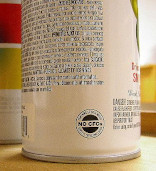
An organic compound is always named in accordance with the longest chain of carbon atoms that contains the functional group. If the substituent is an alkyl group it is known as a branched chain.
Some uses of haloalkanes include:
in fire extinguishers
as aerosol propellants
in refrigeration
generating foamed plastics
solvents in dry cleaning processes (not actually dry, but no water is required)
Chloroform (\(\text{CHCl}_{3}\)) was used as an anesthetic for years. However, aside from causing dizziness, fatigue and headaches, it was discovered to be toxic, often fatally so. Even non-fatal doses can cause damage to the kidneys and liver. Chloroform can sometimes be found in cough syrups, although not often anymore.
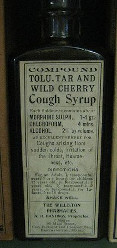
Haloalkanes can contain more than one halogen atom. Chloromethanes are substances that can be used as anaesthetics during operations. One example is trichloromethane, also known as chloroform (Figure 4.33).

Figure 4.33: The (a) structural and (b) molecular formula representations of trichloromethane (chloroform).
Answer these questions on the haloalkanes.
Give the general formula for the haloalkanes with only one halogen atom
\(\text{C}_{\text{n}}\text{H}_{2\text{n}+1}\text{X}\) where X is any halogen atom
Are haloalkanes saturated compounds?
Yes
Draw the structural formulae for:
\(\text{CH}_{2}(\text{Br})\text{CH}_{2}\text{CH}_{3}\)
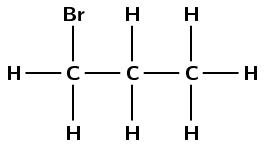
\(\text{CH}_{3}\text{CH}(\text{Cl})\text{CH}_{2}\text{CH}_{3}\)
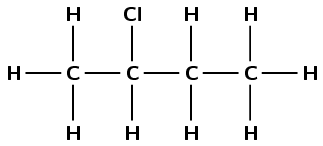
\(\text{CH}_{2}(\text{F})\text{CH}_{3}\)
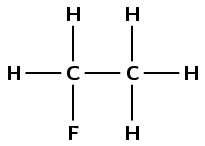
The carbonyl group consists of a carbon atom that is joined to an oxygen by a double bond (see Figure 4.34).
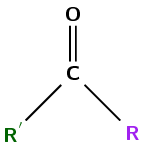
Figure 4.34: A compound containing a carbonyl group.
In Figure 4.34 \(\color{darkgreen}{\textbf{R'}}\) and \(\color{purple}{\textbf{R}}\) are used to represent the rest of the atoms in the molecule. For example \(\color{purple}{\textbf{R}}\) could represent an alkyl chain, or a hydrogen atom.

(a) An aldehyde and (b) a ketone.
If the functional group is on the end of the carbon chain, the organic compound is called an aldehyde (Figure 4.35 (a)). Being at the end of the chain means that \(\color{darkgreen}{\textbf{R'}}\) or \(\color{purple}{\textbf{R}}\) represents a hydrogen atom. The simplest aldehyde is methanal. The aldehyde containing 4 carbon atoms, butanal, is illustrated in Figure 4.36. In this example \(\color{purple}{\textbf{R}}\) represents \(\text{H}\) and \(\color{darkgreen}{\textbf{R'}}\) represents \(\text{CH}_{3}\text{CH}_{2}\text{CH}_{2}\).
Note that the condensed structural formula for an aldehyde ends in \(\text{CHO}\) not \(\text{COH}\). This is because COH could be confused with the hydroxyl (\(-\text{OH}\)) group of an alochol.

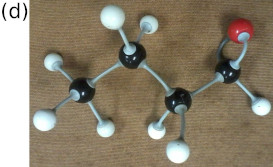
Figure 4.36: The (a) structural, (b) condensed structural and (c) molecular formula representations of butanal. (d) An atomic model of butanal.
Some uses of aldehydes include:
in resins (over \(\text{6}\) million tons of formaldehyde are produced per year)
in the production of plasticisers and alcohols used in detergents
in perfumes and flavourants
If the carbonyl group is in the middle of the carbon chain, the compound is called a ketone (Figure 4.35 (b)). Being in the middle of the chain means that \(\color{darkgreen}{\textbf{R'}}\) and \(\color{purple}{\textbf{R}}\) cannot represent \(\text{H}\). The simplest ketone is propanone (also known as acetone, the compound in nail varnish remover), which contains three carbon atoms. The ketone containing 4 carbon atoms, butanone, is illustrated in Figure 4.37.


Figure 4.37: The (a) structural, (b) condensed structural and (c) molecular formula representations of butanone. (d) An atomic model of butanone.
The molecular formulae representations for butanal and butanone are identical (\(\text{C}_{4}\text{H}_{8}\text{O}\)). This is why structural and condensed structural representations are necessary.
Some uses of ketones include:
as solvents
in the production of polymers
in the production of pharmaceuticals
The general formula for both the aldehydes and ketones can be written as: \(\color{red}{\textbf{C}_{\textbf{n}}\textbf{H}_{\textbf{2n}}\textbf{O}}\). This means that they cannot be told apart from their general formula alone. There are more complex general formulas that allow aldehydes and ketones to be distinguished, but they are not covered in this book.
Carboxylic acids are organic acids that are characterised by having a carboxyl group, written as \(-\text{COOH}\). In a carboxyl group a carbon atom is double-bonded to an oxygen atom (carbonyl group), and it is also bonded to a hydroxyl group (\(\color{purple}{\textbf{R}}\)). The simplest carboxylic acid, methanoic acid, is shown in Figure 4.38 and ethanoic acid is shown in Figure 4.39.

Figure 4.38: The (a) structural, (b) condensed structural and (c) molecular formula representations of methanoic acid.

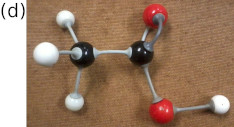
Figure 4.39: The (a) structural, (b) condensed structural and (c) molecular formula representations of ethanoic acid. (d) An atomic model of ethanoic acid.
Carboxylic acids are widespread in nature. Methanoic acid (also known as formic acid) has the formula \(\text{HCOOH}\) and is found in insect stings. Ethanoic acid \((\text{CH}_{3}\text{COOH})\), or acetic acid, is the main component of vinegar. More complex organic acids also have a variety of different functions. Benzoic acid for example, is used as a food preservative. Carboxylic acids have the general formula: \(\color{red}{\textbf{C}_{\textbf{n}}\textbf{H}_{\textbf{2n+1}}\textbf{COOH}}\).
Ethanoic acid can be produced through the oxidation of ethanol upon exposure to the oxygen in air. This is why wine that is left too long can taste acidic. Wine can easily go sour if exposed to the oxygen molecules (\(\text{O}_{2}\)) in the air, especially if the weather is warm.
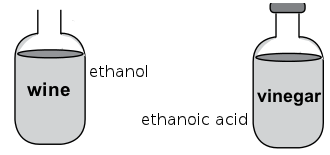

Figure 4.40: The oxidation of wine.
A certain type of ant, called formicine ants, manufacture and secrete formic acid, which is used to defend themselves against other organisms that might try to eat them.
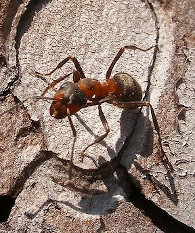
The oxidation of ethanol to ethanoic acid can also be seen in the reaction of ethanol with potassium dichromate:
\(2(\text{Cr}_{2}\text{O}_{7})^{2-}(\text{aq}) + 3\text{C}_{2}\text{H}_{5}\text{OH}(\text{aq}) + 16\text{H}^{+}(\text{aq})\) \(\to\) \(4\text{Cr}^{3+}(\text{aq}) + 3\text{CH}_{3}\text{COOH}(\text{aq}) + 11\text{H}_{2}\text{O}(\text{ℓ})\)
The colour change that occurs is shown in the image below and the following video:
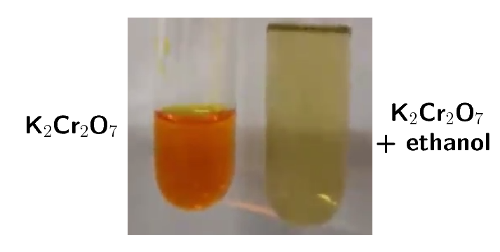
Figure 4.41: The different colours of potassium dichromate (left) and potassium dichromate and ethanol (right). Screenshot taken from video by beggar098 on YouTube.
Read the following extract taken from HowStuffWorks (12/08/13):
The Breathalyzer device contains:
A system to sample the breath of the suspect
Two glass vials containing the chemical reaction mixture
A system of photocells connected to a meter to measure the color change associated with the chemical reaction
To measure alcohol, a suspect breathes into the device. The breath sample is bubbled in one vial through a mixture of sulfuric acid, potassium dichromate, silver nitrate and water. The principle of the measurement is based on the following chemical reaction:
\(2\text{K}_{2}\text{Cr}_{2}\text{O}_{7}(\text{aq}) + 3\text{CH}_{3}\text{CH}_{2}\text{OH}(\text{aq}) + 8\text{H}_{2}\text{SO}_{4}(\text{aq})\) \(\to\)
\(2\text{Cr}_{2}(\text{SO}_{4})_{3}(\text{aq}) + 2\text{K}_{2}\text{SO}_{4} + 3\text{CH}_{3}\text{COOH}(\text{aq}) + 11\text{H}_{2}\text{O}(\text{ℓ})\)
In this reaction:
The sulfuric acid removes the alcohol from the air into a liquid solution.
The alcohol reacts with potassium dichromate to produce: chromium sulfate, potassium sulfate, acetic acid, water
The silver nitrate is a catalyst, a substance that makes a reaction go faster without participating in it. The sulfuric acid, in addition to removing the alcohol from the air, also might provide the acidic condition needed for this reaction.
During this reaction, the reddish-orange dichromate ion changes color to the green chromium ion when it reacts with the alcohol; the degree of the color change is directly related to the level of alcohol in the expelled air. To determine the amount of alcohol in that air, the reacted mixture is compared to a vial of unreacted mixture in the photocell system, which produces an electric current that causes the needle in the meter to move from its resting place. The operator then rotates a knob to bring the needle back to the resting place and reads the level of alcohol from the knob - the more the operator must turn the knob to return it to rest, the greater the level of alcohol.
Break into groups of three or four. Research breathalysers and then report your information to the class.
Make sure to cover the following areas:
The effect of alcohol on the body
The effect of alcohol on reaction times
The origins of the breathalyser
The term mouth alcohol and its effect on breathalyser tests.
Esters will be dealt with in much greater detail in Section 4.7.
When an alcohol reacts with a carboxylic acid, an ester is formed. Most esters have a characteristic smell. In the reaction a molecule of water is removed from the two compounds and a new bond is formed between what remains of the alcohol and the carboxylic acid. A catalyst is required in this reaction, in this case it must be an inorganic acid (e.g. \(\text{H}_{2}\text{SO}_{4}\)). An example is shown in Figure 4.42.

Figure 4.42: The formation of an ester and water from an alcohol and carboxylic acid.
The esterification process is reversible with large quantities of water (although it can be slow). In an acidic environment the reaction speeds up. Reversible reactions are covered in greater detail in Chapter 8.
The esterification process with methanol and methanoic acid is shown with atomic models in Figure 4.43. Esters have the general formula: \(\color{red}{\textbf{C}_{\textbf{n}}\textbf{H}_{\textbf{2n}}\textbf{O}_{\textbf{2}}}\). This general formula can also be applied to carboxylic acids, but the more complex general formula for esters alone is not covered in this book.

Figure 4.43: The esterification process of methanol and methanoic acid to methyl methanoate and water, shown with three-dimensional model kits.
Some common uses for esters are:
in cosmetics and beauty products because they typically have a fruity smell, making them good as artificial flavourants and scents
in nail varnish remover and model plane glue
as solvents for non-water soluble compounds (e.g. oils, resins) because the ester of a specific carboxylic acid will be less water soluble than the carboxylic acid
as plasticisers because esters can make a compound less brittle, and more flexible
Answer these questions on carbonyl compounds.
What other functional group does a carboxylic acid have in addition to a carbonyl group?
hydroxyl group
What is the main difference between aldehydes and ketones
An aldehyde must have the carbonyl group at the end of the carbon chain (carbonyl carbon atom bonded to a hydrogen atom). A ketone must have the carbonyl group in the middle of the chain (carbonyl carbon atom not bonded to a hydrogen atom).
What two reactants are required to make an ester?
alcohol and carboxylic acid
How is ethanoic acid produced?
Through the oxidation of ethanol.
Draw the structural formulae for each of the following compounds. What series does each compound belong to?
\(\text{CH}_{3}\text{COCH}_{3}\)
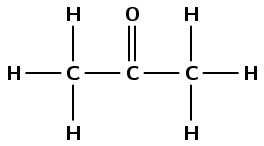
ketone
\(\text{CH}_{3}\text{CH}_{2}\text{COOH}\)
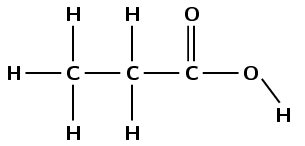
carboxylic acid
\(\text{CH}_{3}\text{CH}_{2}\text{CHO}\)
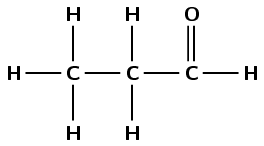
aldehyde
\(\text{CH}_{3}\text{COOCH}_{3}\)
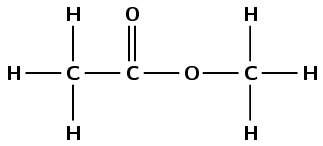
ester
Write down the:
name of the homologous series of:
\(\text{CH}_{3}\text{CH}(\text{CH}_{3})\text{CH}_{2}\text{CH}(\text{CH}_{3})\text{CH}_{2}\text{CH}_{3}\)
All the carbon atoms are bonded to the maximum number of other atoms (four) and there are only hydrogen and carbon atoms in the molecule. Therefore this is an alkane.
OR
Draw the structural formula:
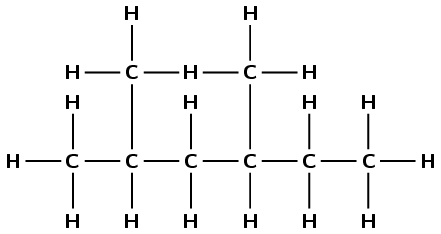
There are only single carbon-carbon bonds, and all the atoms are carbon or hydrogen atoms. Therefore this compound belongs to the alkanes.
general formula of:

\(\text{C}_{\text{n}}\text{H}_{2\text{n}}\)
name of the homologous series of:

esters
structural formula of:
\(\text{CH}_{3}\text{CH}_{2}\text{COOH}\)
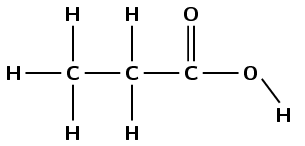
Look at the list of organic compounds in the table below:
|
Organic compound |
Homologous series |
|
\(\text{CH}_{3}\text{CH}_{2}\text{CH}_{2}\text{COOH}\) |
|

|
|
|
\(\text{CH}_{3}\text{CHO}\) |
|

|
|
|
\(\text{CH}_{3}\text{CCCH}_{2}\text{CH}_{2}\text{CH}_{2}\text{CH}_{3}\) |
Complete the table by identifying the functional group of each compound.
|
Organic compound |
Homologous series |
|
\(\text{CH}_{3}\text{CH}_{2}\text{CH}_{2}\text{COOH}\) |
carboxylic acid |

|
ester |
|
\(\text{CH}_{3}\text{CHO}\) |
aldehyde |

|
alkane |
|
\(\text{CH}_{3}\text{CCCH}_{2}\text{CH}_{2}\text{CH}_{2}\text{CH}_{3}\) |
alkyne |
Give the structural representation of the compounds represented by condensed structural formulae.
\(\text{CH}_{3}\text{CH}_{2}\text{CH}_{2}\text{COOH}\)
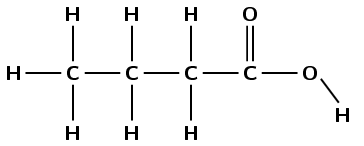
\(\text{CH}_{3}\text{CHO}\)
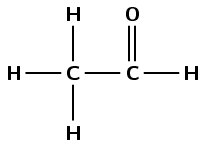
\(\text{CH}_{3}\text{CCCH}_{2}\text{CH}_{2}\text{CH}_{2}\text{CH}_{3}\)

A chemical reaction takes place and ethyl methanoate is formed.
Identify the homologous series to which ethyl methanoate belongs?
Esters
Name the two types of reactants used to produce this compound in a chemical reaction.
alcohol and carboxylic acid
Give the structural formula of ethyl methanoate (\(\text{HCOOCH}_{2}\text{CH}_{3}\)).

The following reaction takes place:
\(\text{CH}_{3}\text{CHCH}_{2}(\text{g})\) + \(\text{H}_{2}(\text{g})\) \(\to\) \(\text{CH}_{3}\text{CH}_{2}\text{CH}_{3}(\text{g})\)
Give the name of the homologous series of the organic compound in the reactants.
Draw the structural representation:
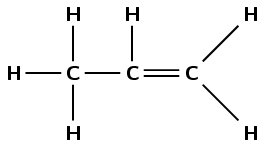
The organic compound in the reactants has a double carbon-carbon bond, therefore it is an alkene.
What is the name of the homologous series of the product?
Draw the structural representation:

The organic compound in the reactants has only single carbon-carbon bonds and no other functional group. Therefore it is an alkane.
Which compound in the reaction is a saturated hydrocarbon?
The product (the alkane), propane.
It is possible for two organic compounds to have the same molecular formula but a different structural formula. Look at the two organic compounds that are shown in Figure 4.44 for example.
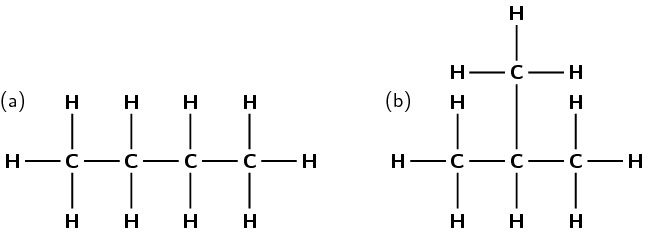
Figure 4.44: Isomers of a 4-carbon organic compound with the molecular formula \(\text{C}_{4}\text{H}_{10}\).
(a) butane and (b) 2-methylpropane.
Both butane and 2-methylpropane (isobutane) are used in camping stoves and lighters.

If you were to count the number of carbon and hydrogen atoms in each compound, you would find that they are the same. They both have the same molecular formula \(\text{C}_{4}\text{H}_{10}\), but their structure is different and so are their properties. Such compounds are called isomers.
In chemistry, isomers are molecules with the same molecular formula but different structural formula.
Isomers are molecules with the same molecular formula and often (though not always) with the same kinds of chemical bonds between atoms, but with the atoms arranged differently.
The isomers shown in Figure 4.44 differ only in the location of the carbon atoms. The functional groups are the same but butane has all four carbons in one chain, while 2-methylpropane has three carbons in the longest chain and a methyl group attached to the second carbon in the chain. It is also possible to have positional isomers (Figure 4.45). In this case the \(-\text{OH}\) functional group can be on different carbon atoms, for example carbon 1 for pentan-1-ol, on carbon 2 for pentan-2-ol or on carbon 3 for pentan-3-ol.
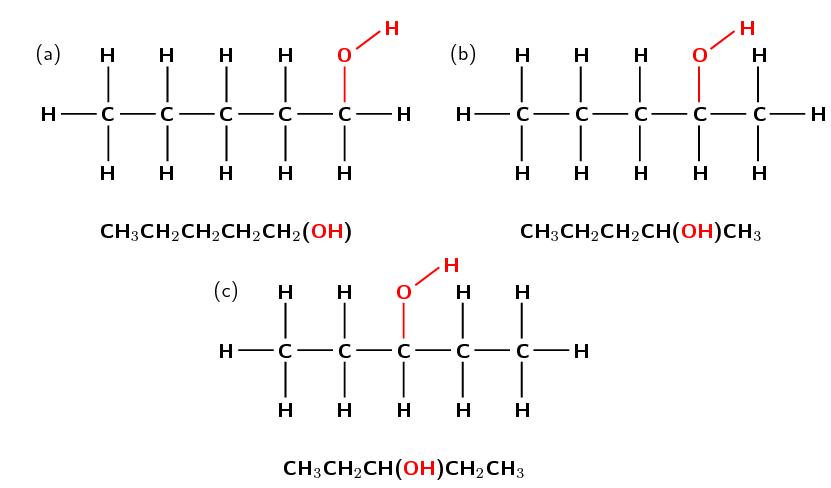
Figure 4.45: The structural and condensed structural representations of the isomers (a) pentan-1-ol, (b) pentan-2-ol and (c) pentan-3-ol.
Positional isomers are also found in esters. If one ester was made from ethanol and hexanoic acid and another was made from hexanol and ethanoic acid the two esters produced are isomers (see Figure 4.46).


Figure 4.46: The structural representations of the isomers (a) ethyl hexanoate and (b) hexyl ethanoate.
It is important to note that molecules need not have the same functional groups to be isomers. For example propanone (commonly known as acetone) and propanal (Figure 4.47) have the same molecular formula (\(\text{C}_{3}\text{H}_{6}\text{O}\)) but different functional groups and properties (Table 4.3). These types of isomers are functional isomers.

Figure 4.47: Two \(\text{C}_{3}\text{H}_{6}\text{O}\) isomers (a) propanone and (b) propanal.
|
Name |
Functional Group |
Melting point (℃) |
Boiling point (℃) |
Reactivity |
|
propanone |
ketone |
\(-\text{95}\) |
\(\text{56}\) |
less reactive |
|
propanal |
aldehyde |
\(-\text{81}\) |
\(\text{48}\) |
more reactive |
Table 4.3: Some properties of the isomers propanone and propanal.
Heptanoic acid and butyl propanoate (Figure 4.48) are another example of functional isomers (containing different functional groups). They both have the same molecular formula of \(\text{C}_{7}\text{H}_{14}\text{O}_{2}\) but have different functional groups and different properties (Table 4.4).
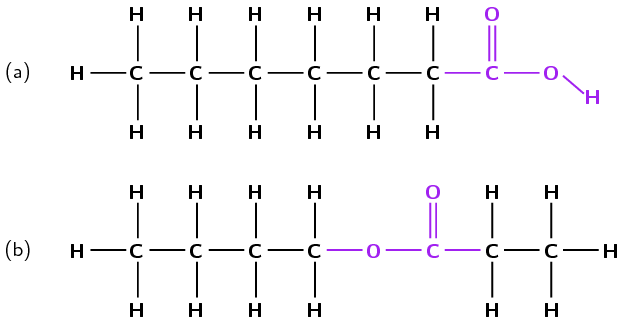
Figure 4.48: The structural representations of the isomers (a) heptanoic acid and (b) butyl propanoate.
|
Name |
Functional group |
Melting point (℃) |
Boiling point (℃) |
|
heptanoic acid |
carboxylic acid |
\(-\text{7,5}\) |
\(\text{223}\) |
|
butyl propanoate |
ester |
\(-\text{89,5}\) |
\(\text{145}\) |
Table 4.4: The different physical properties of the isomers heptanoic acid and butyl propanoate.
Match the organic compound in Column A with its isomer in Column B:
|
Column A |
Column B |
|
|
1 |
\(\text{CH}_{3}\text{CH}_{2}\text{CH}_{2}(\text{OH})\) |
\(\text{CH}_{3}\text{CH}(\text{CH}_{3})\text{CH}_{3}\) |
|
2 |

|

|
|
3 |
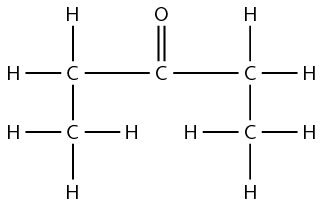
|
\(\text{CH}_{3}\text{CH}(\text{OH})\text{CH}_{3}\) |
A1 (\(\text{CH}_{3}\text{CH}_{2}\text{CH}_{2}(\text{OH})\)) and B3 (\(\text{CH}_{3}\text{CH}(\text{OH})\text{CH}_{3}\)) are isomers.
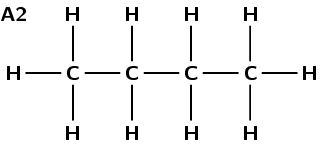
and B1 (\(\text{CH}_{3}\text{CH}(\text{CH}_{3})\text{CH}_{3}\)) are isomers.
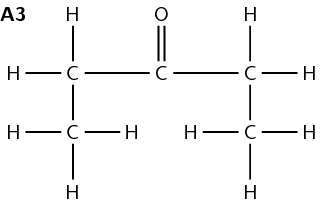
and

are isomers
Give the ketone isomer of butanal:
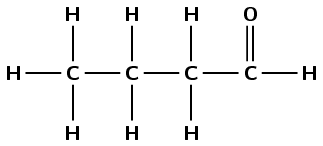
A ketone requires that the carbonyl group is not at the end of the chain. Therefore it must be on carbon 2. The isomer must have the same number of each type of atom: \(\text{C}_{4}\text{H}_{8}\text{O}\)

Give a carboxylic acid that is an isomer of:

The molecule is an ester. A carboxylic acid must have the \(-\text{COOH}\) functional group. The isomer must have the same number of each type of atom: \(\text{C}_{5}\text{H}_{10}\text{O}_{2}\). So there are four options (names not required):
One isomer with no branching methyl groups:
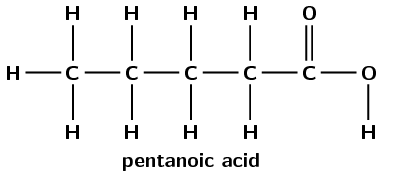
Two isomers that have one branching methyl group:
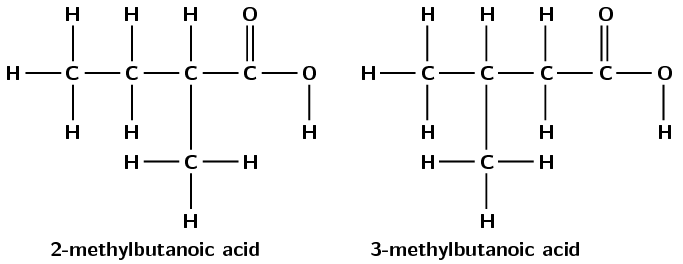
One isomer that has two branching methyl groups:
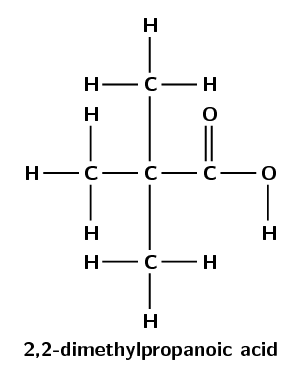
|
Previous
4.1 What are organic molecules?
|
Table of Contents |
Next
4.3 IUPAC naming and formulae
|